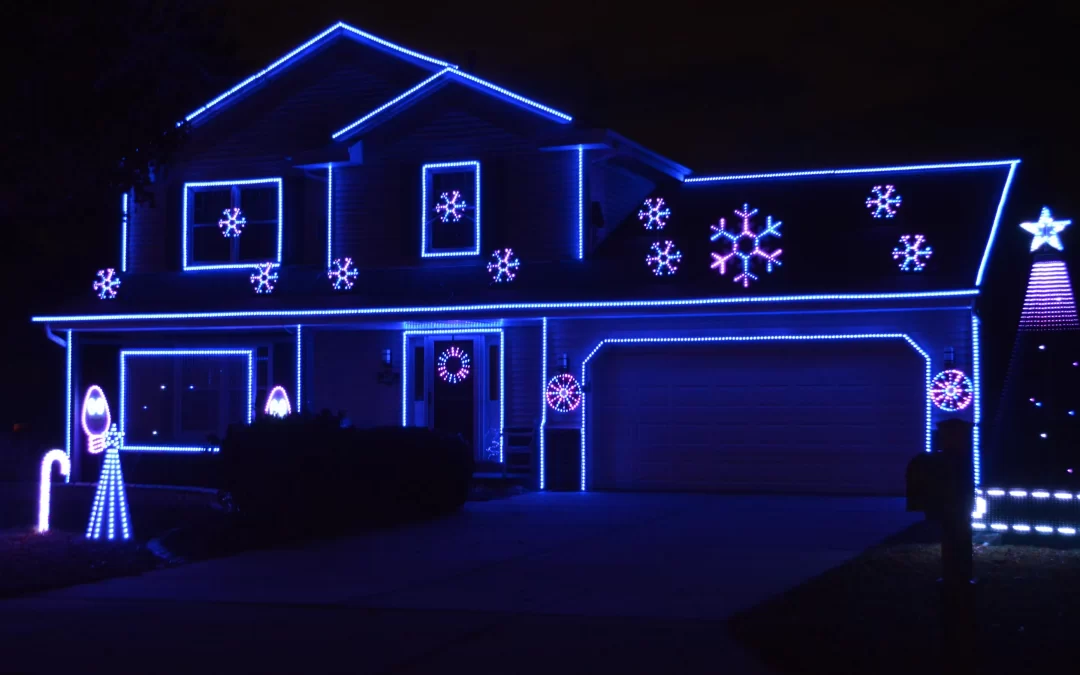Is there anything like Christmas lights to get you into the holiday spirit? From the tree to the front porch and fence, Christmas lights make the holiday season merry and bright. These pretty decorations don’t come without risks, though. Falls, electrocution and even fires are very real possibilities. An average of 770 fires are caused by Christmas lights every year, according to the National Fire Protection Association. Christmas lights can pose a major hazard inside and outside your home. Here’s how to prevent a potential disaster.
Christmas light electrical safety
With proper preparation and safety practices, you can avoid those dangerous situations with your holiday decorations. You just need to take a few precautions inside and outside your home.
Ladders
The type of ladder you use matters. Metal ladders conduct electricity, which can lead to electrical shocks. The Electrical Safety Foundation International recommends using a wooden or fiberglass ladder when hanging lights to avoid electrical shocks.
Beware missing or broken bulbs
Replace any missing or broken bulbs before you string up your porch or tree because they could lead to electrocution, fires or injuries. Most lights come with replacement bulbs, but you can also buy a pack at your local home improvement store for about $3. Fix broken string lights by changing out the fuses.
Type of light
While indoor and outdoor lights are similar in appearance and function, you shouldn’t use them interchangeably. Indoor lights should only be used indoors, and outdoor lights should only be used outside. Here’s why.
Indoor lights have been specifically tested to make sure they aren’t a fire hazard for tree decorating, while outdoor lights are specifically tested to withstand cold and rainy weather. Outside lights could pose a fire hazard if you string them up on the family tree because they’re often hotter, while the indoor lights probably wouldn’t survive the snowstorm.
To be safe, you can purchase lights that are certified for indoor and outdoor usage. Whether you’re using indoor or outdoor, though, the US Fire Administration recommends buying only lights certified by an approved testing facility. No matter the climate where you live, look for the UL seal on the box. That seal means that the lights meet the national industry standards of the American National Standards Institute.
Extension Chords
Like the string lights, you should always only use an extension cord that is rated for outdoor use when stringing up lights on the porch or house. Indoor-use extension cords aren’t made to withstand cold or wet environments.
You shouldn’t let your extension cords sit on the ground. Make sure the junction where your light cord and your extension cord meet stay out of puddles, damp soil, snow or ice because a potentially damaged extension cable could cause injury or death from electrocution, fire, or carbon monoxide poisoning if wet.
You can buy an inexpensive cord protector — like the Twist and Seal Heavy Duty Cord Protector — to keep your cords dry and safe. You could also plan your light display so that connections are suspended off the ground instead of sitting in contact with it.
Tripping Hazards
Keep your light strands off the ground, too. Lights and cords on the ground pose a tripping hazard and can easily be broken if stepped on. If you want to make a cool runway effect down your walkway, use light stakes. You just stick them in the ground and the lights clip to the top of the stake.
You can also use anchoring pins or ground staples to secure extension cords to the ground on either side of a walkway to prevent tripping hazards. Simply thread the cord through the middle and push the ends of the pin or staple into the dirt. If you have some wire hangers, a pair of pliers and wire cutters lying around, you can make your own staples in a pinch. Just cut 8 inches of wire and bend it into a U-shape.
Don’t make your lights a year-long attraction
Sure, they’re pretty, but don’t leave your lights on for too long. Many lights, including smart lights, aren’t meant for long-term use. Be sure to check the light box for information on just how long you can safely leave your lights up.
Ground fault circuit interrupter
We recommend plugging your lights into a ground fault circuit interrupter (GFCI) outlet. These outlets will shut the circuit down if there is too much current flowing through, preventing fires. If your outlet is a GFCI, it will have a reset and test button in the center. If you don’t have one, you can purchase a portable GFCI outlet from your home-improvement store. The best is a waterproof in-line GFCI. A Mikulka electrician can install an outdoor or indoor GFI in your home or office.
Contact us
Mikulka Electricians are always professional and efficient. Insured and trained to do the job right the first time. Experts in the field of electrics with over 25 years’ experience. Prepared with up-front pricing and a lifetime guarantee. We observe all personal protective equipment and COVID 19 requirements to keep our staff and your family safe. Our team of experts will respond immediately to your call for help. Call Mikulka Electric, Inc. for a wide range of electrical services, including indoor and outdoor lighting, electrical heating, electrical repairs, and back-up generators. We service the Central New Jersey area. Address 275 RT. 79 Morganville, NJ 07751 https://mikulka-electric.com/contact-us/

